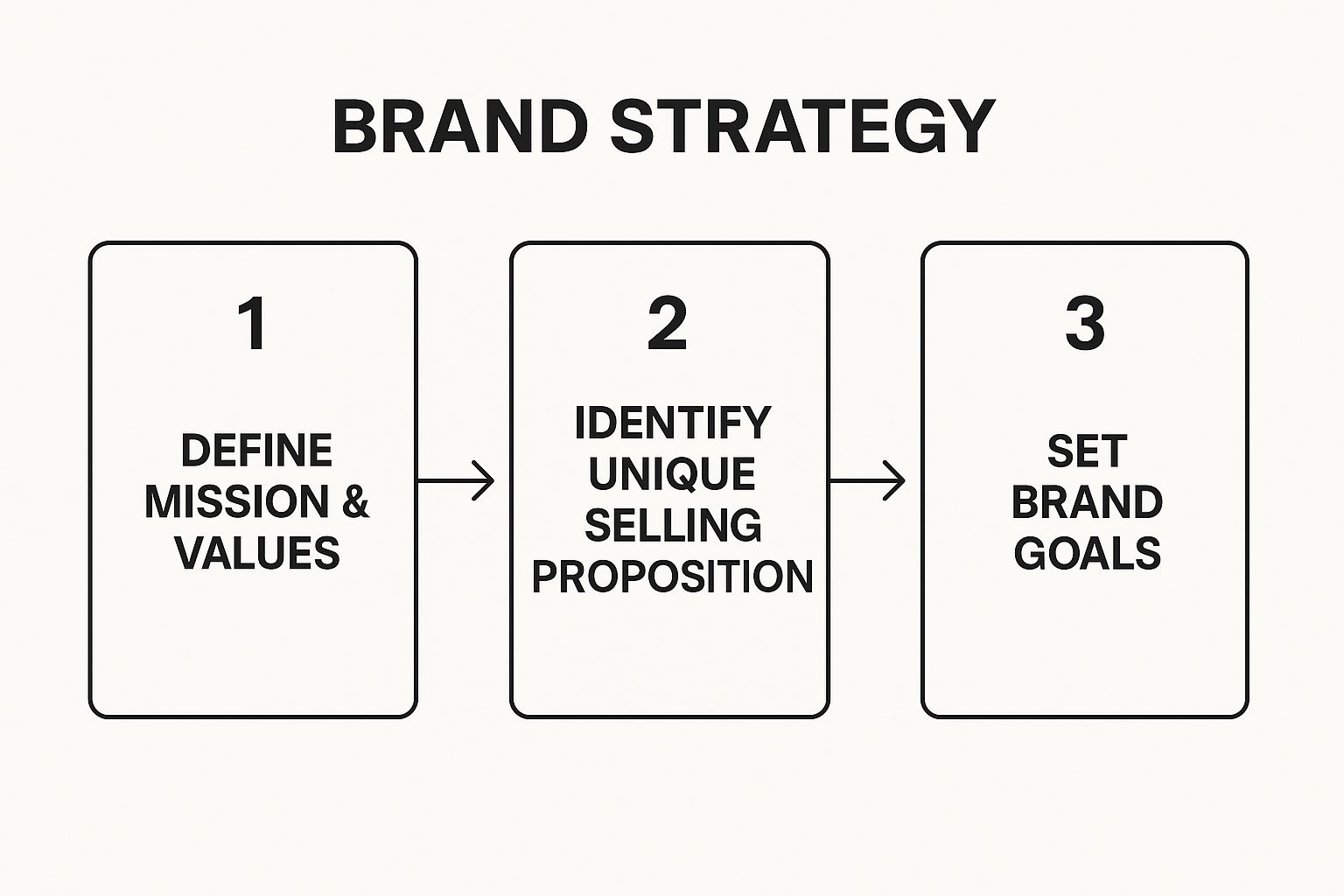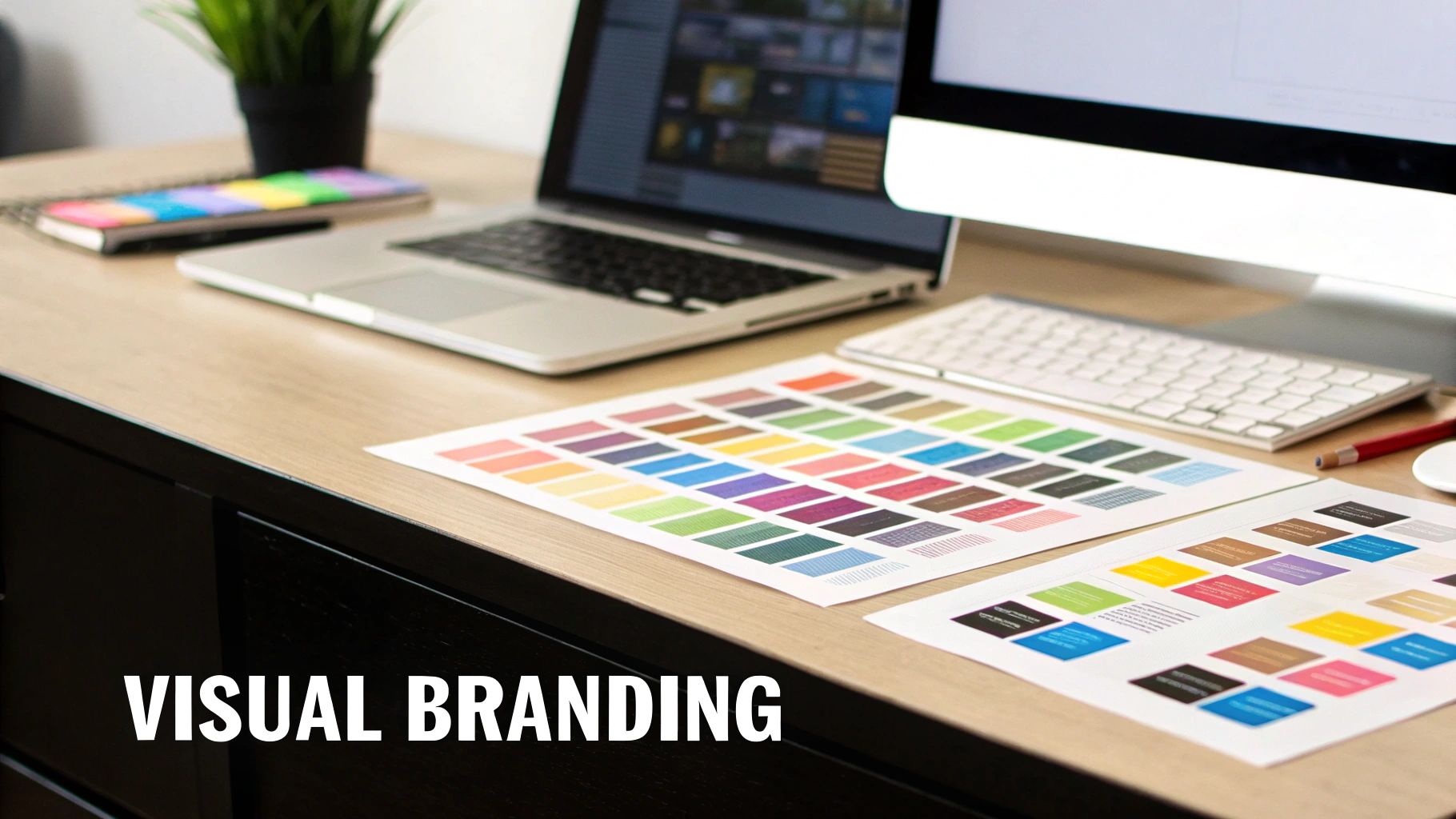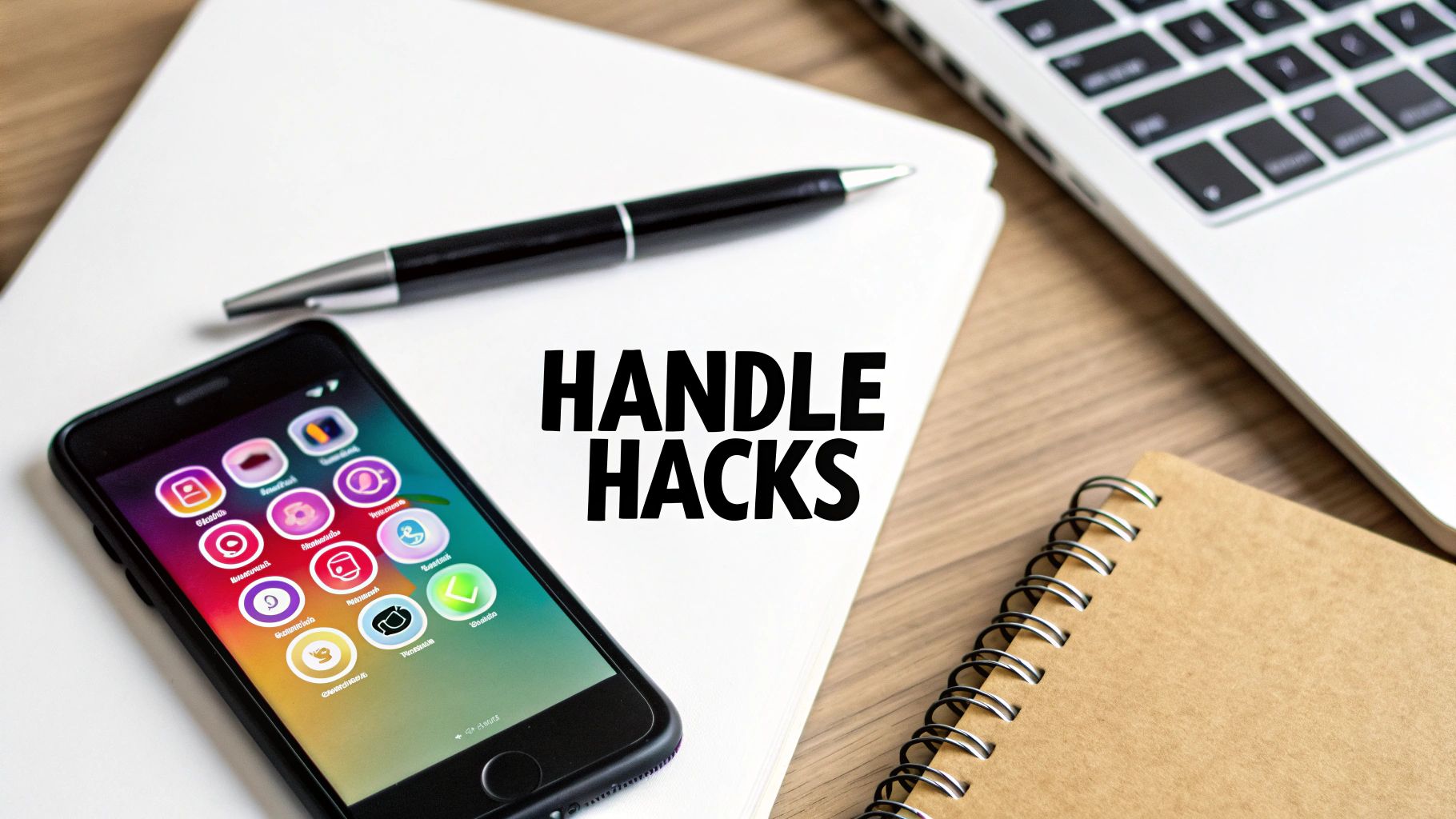If you want to build a brand that lasts, you have to get one thing straight: it's not just about a cool logo or a snappy tagline. A brand is the entire gut feeling someone has about your business. It’s the sum of every single interaction they have with you, from your social media posts to your customer service.
It’s all about intentionally shaping how people perceive you, and that starts with defining your purpose, mission, and values to make a real, positive impression.
What Does It Really Mean to Build a Brand?

It’s easy to fall into the trap of thinking branding is just a design project. While your visual identity is definitely a big piece of the puzzle, a powerful brand is built on something much deeper. Think of it as your company’s personality.
Is your brand sleek and innovative like Apple, or is it more rugged and outdoorsy like Patagonia? That feeling doesn’t just happen by chance. It's carefully constructed from a core set of beliefs that should steer every decision you make.
The Core Components of a Strong Brand
At its heart, branding is about making a promise to your customer and then showing up to deliver on it, time and time again. This promise is communicated through three foundational pillars.
- Brand Purpose (The "Why"): This is your reason for being, beyond just turning a profit. Think about Dove—their purpose is to make a positive experience of beauty accessible to every woman. That's a powerful "why."
- Brand Mission (The "How"): This is your action plan. It outlines what you do, who you do it for, and what makes your approach different.
- Brand Values (The "What"): These are the non-negotiable principles that guide your company’s behaviour. Things like "sustainability," "innovation," or "community focus" shape everything from your internal culture to your public image.
When these elements are aligned, they create a cohesive identity. They inform your product development, your marketing campaigns, and even how your team answers the phone.
From Selling Products to Building Connections
Here’s where things get interesting. When your brand has a clear purpose and genuinely lives by its values, you start attracting people who share those same beliefs. In fact, one study found that 77% of consumers prefer to buy from brands that share their values. You’re no longer just pushing a product; you’re building a community.
Take the shoe brand TOMS. Their "One for One" model was never just a clever marketing ploy; it was a direct expression of their core purpose. People weren't just buying shoes—they were buying into a mission. That created an emotional connection that went far beyond the product itself, turning customers into genuine advocates.
A brand's real power comes from its ability to create a shared sense of meaning. It becomes a part of your customer's identity, reflecting who they are and what they stand for.
Ultimately, building a brand means creating a consistent, memorable experience that earns trust and inspires loyalty. It’s about deciding what you stand for and then proving it with every single thing you do. That’s the authentic approach that separates forgettable businesses from the iconic brands that truly last.
Defining Your Unique Brand Position
Once you’ve nailed down your brand’s purpose, it’s time to find your specific place in the market. Brand positioning isn’t about trying to be everything to everyone. It’s the exact opposite—it's about becoming the absolute best choice for a very specific group of people. This is where your unique strengths meet the real needs of your ideal customer.
The whole point is to give people a clear, compelling reason to choose you over anyone else. To build your brand from the ground up, you first have to get crystal clear on who you're for, what problem you solve for them, and what makes your way of solving it different. That clarity becomes the north star for your messaging, marketing, and every single customer interaction.
Go Deep on Your Ideal Customer
You can't position a brand if you don't know who you're talking to. And I mean really know them. Basic demographics like age and location are just the starting point. You need to get inside their head and understand their world.
What are their biggest headaches when it comes to your industry? What are they trying to achieve? What keeps them up at night? One of the most powerful things you can do is build out a detailed customer persona. Give this person a name, a job, and a backstory.
Imagine a small, eco-conscious coffee shop in Berlin. Their ideal customer might be "Sustainable Sarah," a 32-year-old graphic designer who cares deeply about ethical sourcing and supporting local businesses. For her, buying a coffee isn't just a transaction; it's a vote for the kind of world she wants to live in. Knowing what drives Sarah helps the coffee shop shape everything from its loyalty programme to its Instagram posts.
Scope Out the Competition
Let's be real—you don't exist in a bubble. Your customers have other options, and you need to know exactly what they are. A competitive analysis isn't about stealing ideas; it's about spotting gaps and finding opportunities to be different.
Start by listing out your top three to five competitors, both direct and indirect. For each one, take a hard look at:
- Their Messaging: What are they promising their customers? What story are they telling?
- Their Audience: Who are they clearly trying to attract?
- Their Strengths & Weaknesses: What are they genuinely good at, and where are they dropping the ball?
This exercise will show you where the market is crowded and, more importantly, where it’s wide open. Maybe all your competitors are racing to the bottom on price. That could be a golden opportunity for a premium brand focused on quality and exceptional service. Or perhaps they all sound a bit corporate and stuffy, leaving a perfect opening for a brand with a friendly, human voice.
A brand doesn't become powerful by being like everyone else. Its strength comes from articulating a unique point of view and consistently delivering on a promise that others can't or won't make.
Write Your Positioning Statement
Okay, with a sharp picture of your customer and the competitive landscape, you're ready to write your brand positioning statement. Think of this as an internal compass—a short, powerful summary that guides every decision you make. It's not a public tagline, but it's the strategic thinking that fuels your tagline.
Here's a simple formula that works wonders:
For [Target Audience], [Your Brand] is the only [Category/Industry] that delivers [Unique Benefit/Promise] because [Reason to Believe].
Let’s go back to our coffee shop. Their statement might look something like this: "For environmentally conscious locals in Berlin, 'Urban Grind' is the only coffee shop that delivers a truly guilt-free caffeine experience because we source our beans directly from fair-trade farms and use 100% compostable packaging."
See how specific and defensible that is? It states exactly who they serve, the unique value they provide, and the proof behind their promise. This kind of strategic clarity is a massive advantage. The power of strong branding is clear in market trends; the top 50 German brands saw their combined value jump by 24% to $506 billion, driven in large part by their strong global identities. You can dig into the full Kantar report on German brand value to see the data for yourself.
By defining your unique position, you're not just writing a mission statement; you're giving your brand a roadmap. Every piece of content, every new feature, and every customer email should echo this core idea, helping you build your brand into one that people remember and choose.
Crafting Your Brand’s Look and Feel
With your strategy locked in, it's time for the fun part: giving your brand a face and a voice. This is where you take all those core ideas and turn them into tangible things people can actually see, hear, and connect with. Your visual and verbal identity are the tools you’ll use every day to build your brand in your audience's minds, making your promise tangible and your personality feel real.
It’s about creating a sensory experience that’s instantly recognisable as yours.
This isn't just about picking your favourite colours or a font that looks cool. Every choice has to be deliberate, designed to back up your brand's positioning and stir up specific feelings. Get this right, and the payoff is huge—consistent visuals can boost brand recognition by a massive 80%. It really shows how every single design element needs to be telling the same story.
The infographic below really nails how this creative phase builds on the strategic work you've already done.

As you can see, a clear mission, a powerful unique selling proposition, and solid goals are the non-negotiable foundations for creating a brand identity that actually works.
Shaping Your Visual Identity
Think of your visual identity as your brand's wardrobe. It's the collection of design elements that work together to create a distinct look, and it needs to perfectly match your brand's personality and be appropriate for every occasion, from a social media post to a formal proposal.
So, what makes up your brand's visual identity? While there are many components, a solid visual identity is built on a few core pillars. Each element plays a distinct role, from your logo acting as a memorable signature to your colour palette setting the emotional tone. Getting these elements to work in harmony is what separates a forgettable business from an iconic brand.
Let’s break down the essential pieces and their strategic purpose.
Key Elements of Brand Identity
| Brand Element | Purpose | Key Considerations |
|---|---|---|
| Logo | Your brand's primary signature and most recognisable asset. | Must be simple, memorable, and versatile enough for all applications (e.g., app icon, billboard). |
| Colour Palette | Evokes emotion and sets the overall mood. | Choose colours based on psychological associations that align with your brand's personality. |
| Typography | Communicates personality and ensures readability. | Serif fonts can feel traditional, while sans-serif fonts often feel modern and clean. Consistency is key. |
| Imagery | Shows your brand in action and tells a visual story. | The style—professional, candid, illustrative—must align with your brand's voice and values. |
| Brand Voice | Builds connection and expresses your brand's personality. | Define your voice with 3-5 adjectives (e.g., witty, knowledgeable, empathetic) and maintain it everywhere. |
Ultimately, these elements are the building blocks of perception. They are the shortcuts your audience uses to understand who you are and what you stand for, long before they ever read a word of your copy.
Finding Your Brand Voice
While your visuals grab someone's attention, it’s your voice that keeps it. Your brand's voice is how you speak across every single touchpoint—from the copy on your website to social media captions and even customer service emails. A consistent voice makes your brand sound human, and that's absolutely essential for building genuine trust and connection.
To start defining your voice, think about a few adjectives that truly describe your brand’s personality. Are you witty and a bit informal? Or are you more authoritative and professional? Maybe your brand is warm and encouraging.
Take the oat milk brand Oatly, for example. They've mastered a quirky, humorous, and slightly rebellious voice in all their communications. This tone perfectly matches their positioning as a challenger to the traditional dairy industry. It makes them unforgettable and helps them connect with a specific crowd that gets their personality.
A brand voice isn't about what you say, but how you say it. It’s the consistent expression of your brand’s personality that turns followers into a community and browsers into buyers.
Creating a Simple Style Guide
So, how do you make sure everyone on your team (or just you, if you're flying solo) uses these elements consistently? You create a brand style guide. This doesn't need to be some hundred-page corporate behemoth. Honestly, a simple one-pager can make all the difference in your mission to build your brand cohesively.
Here’s what your basic style guide should cover:
- Logo Usage: Show your main logo, any variations, and provide crystal-clear rules on how and where to use them. I always recommend including spacing guidelines and a few "what not to do" examples.
- Colour Palette: Display your primary and secondary colours with their specific codes (HEX for web, CMYK for print) so there's no guesswork.
- Typography: Clearly state your fonts for headlines, sub-headings, and body text. Include details on sizing and weight to create a clear visual hierarchy.
- Brand Voice & Tone: Sum up your brand's personality in three to five keywords (e.g., "Confident, an expert, but approachable"). Then, add a quick example of what that sounds like in practice.
This guide becomes your North Star. It ensures that every single thing you create—a blog post, a social media update scheduled with Trustypost, or an email newsletter—feels like it came from the same, unified brand. That consistency is what turns a random collection of assets into a brand experience people remember and trust.
Building Your Digital Brand Presence

You can have the most brilliant brand strategy in the world, but it doesn't mean much until it meets your audience. These days, that first handshake almost always happens online. A strong digital presence isn’t a bonus feature anymore; it’s the primary way people will find you, size you up, and decide if they want to connect.
The real challenge is making sure your brand feels the same everywhere. Whether someone lands on your website or just scrolls past a quick post on Instagram, that interaction should reinforce who you are. Every click, like, and share is a small but crucial part of how you build your brand.
Your Website: The Digital Hub
Think of your website as your brand’s home base. It's the one piece of online real estate you truly own and control. Social media platforms are powerful, but you're essentially renting space there—algorithms and rules can change overnight. All roads should ultimately lead back to your website.
A professional, easy-to-use site is non-negotiable. It needs to be a direct reflection of your visual identity and brand voice. When someone arrives, they should immediately get a sense of who you are, what you do, and what they should do next. This is your space to tell your full story, free from character limits and the distractions of a social feed.
Crafting a Strategic Social Media Footprint
Social media is often the heartbeat of a digital brand, but the secret isn't to be everywhere. Trying to manage a presence on every single platform is a fast track to burnout and watered-down content. The smarter move is to figure out where your ideal customers actually hang out and meet them there.
For instance, a B2B consultancy will likely find its home on LinkedIn and X (formerly Twitter). In contrast, a brand selling beautiful handcrafted jewellery belongs on visual-first platforms like Instagram and Pinterest.
Choosing the right platforms isn't about chasing the latest trend. It's a deliberate decision to invest your energy where you can build the most meaningful connections with the right people.
Once you've picked your channels, consistency is everything. This goes way beyond just posting on a schedule. Your voice, visuals, and core messages have to be aligned across the board to create a seamless experience for your followers. Having a clear plan is essential, which is why our guide on creating a social media content strategy is a great place to start organising your efforts.
The simple fact is, social media's role in shaping how people see your brand is huge. In Germany alone, there are over 67.8 million social media users—that’s more than 80% of the population. The average person uses 5.4 different social accounts, giving you multiple chances to connect. And with 95.1% of users accessing these platforms via mobile, your content absolutely must be optimised for small screens.
Content Marketing That Builds Authority
Beyond quick social media updates, content marketing is how you prove your expertise and earn genuine trust. It’s all about creating and sharing things your audience actually finds useful—content that solves their problems or piques their interest.
Here are a few formats that pack a punch:
- Blogging: A blog is a powerhouse for SEO and the perfect place to share in-depth knowledge, dive into company news, or feature customer success stories.
- Video Content: From short, snappy clips on TikTok and Instagram Reels to detailed tutorials on YouTube, video brings your brand’s personality to life like nothing else.
- Email Newsletters: Email is still one of the most direct ways to build relationships. It’s your channel to offer exclusive content, updates, and promotions right to their inbox.
By consistently delivering value, you stop being just another company trying to sell something. You become a go-to resource, an authority in your field. This shift from selling to helping is how you build your brand for real, long-term loyalty and growth.
Turning Your Audience Into a Community

Having a digital presence is a great start, but it's really only half the battle. The real goal when you build your brand isn’t just to collect passive followers; it’s to nurture a vibrant community of people who genuinely champion what you do. An audience listens, but a community gets involved, shares their thoughts, and feels a real sense of belonging.
This is where you shift from broadcasting a one-way message to hosting a two-way conversation. It’s the point where your brand stops being something you talk about and starts being something people talk with. This is how true, lasting loyalty is built.
Foster Genuine Engagement
Engagement is so much more than just counting likes and comments. It's about sparking real interactions that make people feel seen, heard, and valued. Think of your social media channels less like a billboard and more like a lively local café.
Proper community management is an active job. When someone takes the time to leave a thoughtful comment, a simple "Thanks!" doesn't cut it. Show you're actually listening by asking follow-up questions or acknowledging their point. This creates a space where real conversation can flourish.
Try creating content that actively invites people to join in:
- Polls and Quizzes: Get opinions on new product ideas or just ask fun, brand-related questions.
- "Ask Me Anything" (AMA) Sessions: Host a live chat with your founder or team members. It’s a fantastic way to build transparency and personal connection.
- Interactive Challenges: Encourage your followers to participate in a brand-related activity and share what they create.
These simple efforts can transform your platforms from a monologue into a dialogue, making your audience feel like active participants in your brand's journey. To keep things fresh, it’s always smart to keep an eye on what’s next. Understanding the upcoming social media trends for 2025 can give you a head start on creating content that truly resonates.
Highlight User-Generated Content
One of the most effective ways to make your audience feel appreciated is to put them in the spotlight. User-generated content (UGC) is any content—photos, videos, reviews, testimonials—created by your customers, not your marketing team. Showcasing it is a massive win for everyone.
For one, it provides authentic social proof. People trust recommendations from their peers far more than they’ll ever trust an advert. But more importantly, it celebrates your customers and makes them feel like a crucial part of your brand’s story. When you re-share a customer's photo or feature their testimonial, you're sending a powerful message: "We see you, and we appreciate you."
When you make your audience the hero of your brand's story, you create a powerful bond. They transition from being simple consumers to becoming proud co-creators and enthusiastic ambassadors.
Nurture Relationships Beyond Social Media
While social media is perfect for broad engagement, your email list is where you can build deeper, more personal connections. These are your most engaged supporters—people who have explicitly asked to hear from you.
Use your emails to offer exclusive content, early access to sales, or behind-the-scenes glimpses of your work. This isn't just about sending promotions; it’s about nurturing that relationship. Share valuable insights, tell compelling stories, and continue the conversations you started on social media. This direct line of communication makes them feel like part of an inner circle, which only strengthens their loyalty.
This kind of deep connection is absolutely essential, especially in competitive markets. For example, Germany's eCommerce market is booming and projected to hit $107.85 billion. To stand out there, brands need localised strategies that truly resonate with consumers, turning casual browsers into a loyal community. By making your customers feel like insiders, you build your brand into a tribe they are proud to belong to.
Common Questions About Building a Brand
Jumping into the world of branding can feel like staring up at a mountain. It's a huge undertaking with a lot of moving parts, so it's completely normal to feel a bit lost at the start. Let’s clear the air and tackle some of the most common questions that come up when you get serious about building your brand.
Think of this as your field guide for cutting through the noise. Getting clear, honest answers now will save you countless headaches and missteps down the line.
How Much Should I Budget for Branding?
This is always the million-dollar question, isn't it? The truth is, there’s no single price tag. A solo founder bootstrapping their business might handle the strategy themselves, investing sweat equity instead of cash. For them, the initial cost might just be a simple logo and a website theme.
But a growing company aiming to seriously professionalise its image could easily invest thousands. That kind of budget often covers a deep-dive brand strategy workshop, a full visual identity system from a pro designer, a custom-built website, and professional photography.
The trick is to be smart about it. Start with the essentials that will make the biggest first impression on your audience, and plan to scale from there.
- DIY Approach: Perfect for startups on a shoestring budget. Your main investment here is time spent getting your core strategy right.
- Freelancer Route: A great middle ground. You can bring in experts for specific jobs, like getting that killer logo designed or nailing your website copy.
- Agency Partnership: The all-in option. This is the most comprehensive (and expensive) choice, ideal for established businesses that need a complete overhaul or a high-stakes launch.
Your brand is an investment, not an expense. The right branding pays for itself over time through increased customer loyalty, higher perceived value, and clearer market positioning. Start where you are, but always prioritise strategic clarity over flashy design.
Can I Build a Brand by Myself?
Absolutely. In fact, some of the most authentic and beloved brands were built brick-by-brick by their founders. If you’re a solopreneur or leading a small team, you have a massive advantage: you can pour your genuine personality and passion directly into the brand. You’re on the front lines, controlling every touchpoint and ensuring the experience is consistent.
The most important thing is to become a student of branding. Carve out time to really understand the fundamentals—get inside your audience's head, define what makes you different, and craft a message that is impossible to ignore. Taking the hands-on approach forces a level of introspection that often leads to a much stronger, more authentic brand.
How Long Does It Take to Build a Brand?
Let's be clear: building a brand is a marathon, not a sprint. You can get the foundational pieces in place—your strategy, logo, and website—in a matter of weeks or a few months. But earning a solid reputation and a spot in your customers' minds? That takes consistent, dedicated effort over years.
It’s a lot like building a relationship. A great first impression opens the door, but it’s the ongoing, reliable, and positive interactions that build real trust and loyalty. Some of your efforts will show quick wins, while others are about playing the long game. It's a constant cycle of creating, listening, and refining.
How Do I Know If My Branding Is Working?
Measuring your brand's success isn't as simple as looking at a sales report, but it’s every bit as crucial. To get the whole story, you need to combine the hard data with the softer, human feedback.
On the data side, start tracking key performance indicators (KPIs) that act as a health check for your brand. These metrics show you how people are actually engaging with you online. You can get a much deeper understanding of which numbers to watch in our detailed guide to social media KPIs.
But don't just live in spreadsheets. Pay close attention to the chatter around your brand. What are people saying about you on social media? What’s the tone of their reviews? A rising tide of positive sentiment, more people mentioning you without being asked, and genuine testimonials are all powerful signals that you’re on the right track.
Ready to make your social media branding effortless? Trustypost is your AI-powered ghostwriter that learns your brand voice and generates on-brand content in minutes. Stop the content grind and start building a consistent, professional presence today. Discover how it works at https://trustypost.ai.



